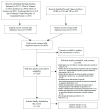Factors Associated with Outpatient Satisfaction in Tertiary Hospitals in China: A Systematic Review
- PMID: 32992600
- PMCID: PMC7579147
- DOI: 10.3390/ijerph17197070
Factors Associated with Outpatient Satisfaction in Tertiary Hospitals in China: A Systematic Review
Abstract
Outpatient care is made up of medical procedures, tests, and services that can be provided to the patient in a setting that doesn't involve an overnight hospital stay. In China, tertiary hospitals are medical services centers of health care systems, and some tertiary hospitals had more than 20,000 outpatient visits per day. However, a systematic review of existed evidence on factors influencing the outpatient satisfaction in tertiary hospitals in China could inform the efforts and does not yet exist. Therefore, in order to better understand the outpatient satisfaction provided by tertiary hospitals in China, we carried out a systematic review following PRISMA guidelines. Studies reporting on the level of and factors associated with outpatient satisfaction in Chinese tertiary hospitals were systematically searched in both Chinese and English electronic databases. A total of 36 articles reported 35 studies that met the inclusion criteria. Out of these eight were household surveys covering 12,119 residents, and another 27 directly interviewed 45,930 outpatients during their hospital visits from 185 hospitals. The included studies generally used self-designed questionnaire and indicated there is a lack of standardized questionnaire for investigating outpatient satisfaction in China. The outpatients showed the highest satisfaction with the doctors and nurses and the lowest satisfaction with the hospital hygiene and outpatient procedures, especially with the long waiting time. The socio-demographic characteristics (e.g., age, marital status, income and education levels), professional skills and service attitudes of medical staff were reported to be associated with outpatient satisfaction. The results indicated that in China, the outpatient satisfaction can be largely improved. Firstly, the attitude of medical service providers, especially the pre-diagnosis nurses, registration officers, and pharmaceutical counters should be improved. Furthermore, to shorten the waiting time, policies should be developed to guide patients with common diseases and slight discomforts to community health systems to alleviate the overload in tertiary hospitals. Considering the strained relations between the doctors and patients in the clinical practice, improving patient satisfaction in China deserves more attention and research.
Keywords: doctor-patient communication/interaction; evidence-based medicine; health services research; patient satisfaction; quality of care.
Conflict of interest statement
The authors declare no conflict of interest.
Figures
Similar articles
-
Factors Associated with Outpatient Satisfaction in Provincial Tertiary Hospitals in Nanchang, China: A Structural Equation Modeling Approach.Int J Environ Res Public Health. 2022 Jul 6;19(14):8226. doi: 10.3390/ijerph19148226. Int J Environ Res Public Health. 2022. PMID: 35886078 Free PMC article.
-
How Perceived Quality of Care Affects Outpatient Satisfaction in China: A Cross-Sectional Study of 136 Tertiary Hospitals.Inquiry. 2019 Jan-Dec;56:46958019895397. doi: 10.1177/0046958019895397. Inquiry. 2019. PMID: 31884866 Free PMC article.
-
The situation and influencing factors of outpatient satisfaction in large hospitals: Evidence from Henan province, China.BMC Health Serv Res. 2021 May 25;21(1):500. doi: 10.1186/s12913-021-06520-2. BMC Health Serv Res. 2021. PMID: 34034724 Free PMC article.
-
Evidence Brief: Comparative Effectiveness of Appointment Recall Reminder Procedures for Follow-up Appointments [Internet].Washington (DC): Department of Veterans Affairs (US); 2015 Jul. Washington (DC): Department of Veterans Affairs (US); 2015 Jul. PMID: 27606388 Free Books & Documents. Review.
-
Evidence Brief: The Quality of Care Provided by Advanced Practice Nurses [Internet].Washington (DC): Department of Veterans Affairs (US); 2014 Sep. Washington (DC): Department of Veterans Affairs (US); 2014 Sep. PMID: 27606392 Free Books & Documents. Review.
Cited by
-
Impact of the COVID-19 pandemic on clinical trials: a cross-sectional questionnaire study in China.Ann Transl Med. 2022 Nov;10(21):1154. doi: 10.21037/atm-22-777. Ann Transl Med. 2022. PMID: 36467359 Free PMC article.
-
Patient-physician communication in the emergency department in Taiwan: physicians' perspectives.BMC Health Serv Res. 2022 Feb 5;22(1):152. doi: 10.1186/s12913-022-07533-1. BMC Health Serv Res. 2022. PMID: 35123459 Free PMC article.
-
Assessing reliability and validity of the Chinese version of the Crown-Crisp Experience Index and its application in pneumoconiosis patients.BMC Psychiatry. 2023 Apr 18;23(1):263. doi: 10.1186/s12888-023-04731-x. BMC Psychiatry. 2023. PMID: 37072712 Free PMC article.
-
Influence of cancer in pregnancy on obstetric and neonatal outcomes: an observational retrospective cohort study.J Gynecol Oncol. 2024 Nov;35(6):e74. doi: 10.3802/jgo.2024.35.e74. Epub 2024 Mar 11. J Gynecol Oncol. 2024. PMID: 38522950 Free PMC article.
-
Validation of French versions of the 15-item picker patient experience questionnaire for adults, teenagers, and children inpatients.Front Public Health. 2024 Feb 19;12:1297769. doi: 10.3389/fpubh.2024.1297769. eCollection 2024. Front Public Health. 2024. PMID: 38439757 Free PMC article.
References
-
- National Health and Family Planning Commission of the People’s Republic of China [(accessed on 28 August 2019)];The Situation of National Medical Service Delivery in China in 2014. Available online: http://www.nhfpc.gov.cn/mohwsbwstjxxzx/s7967/201501/0faf05af332b4f9f83bc....
Publication types
MeSH terms
LinkOut - more resources
Full Text Sources
Miscellaneous



